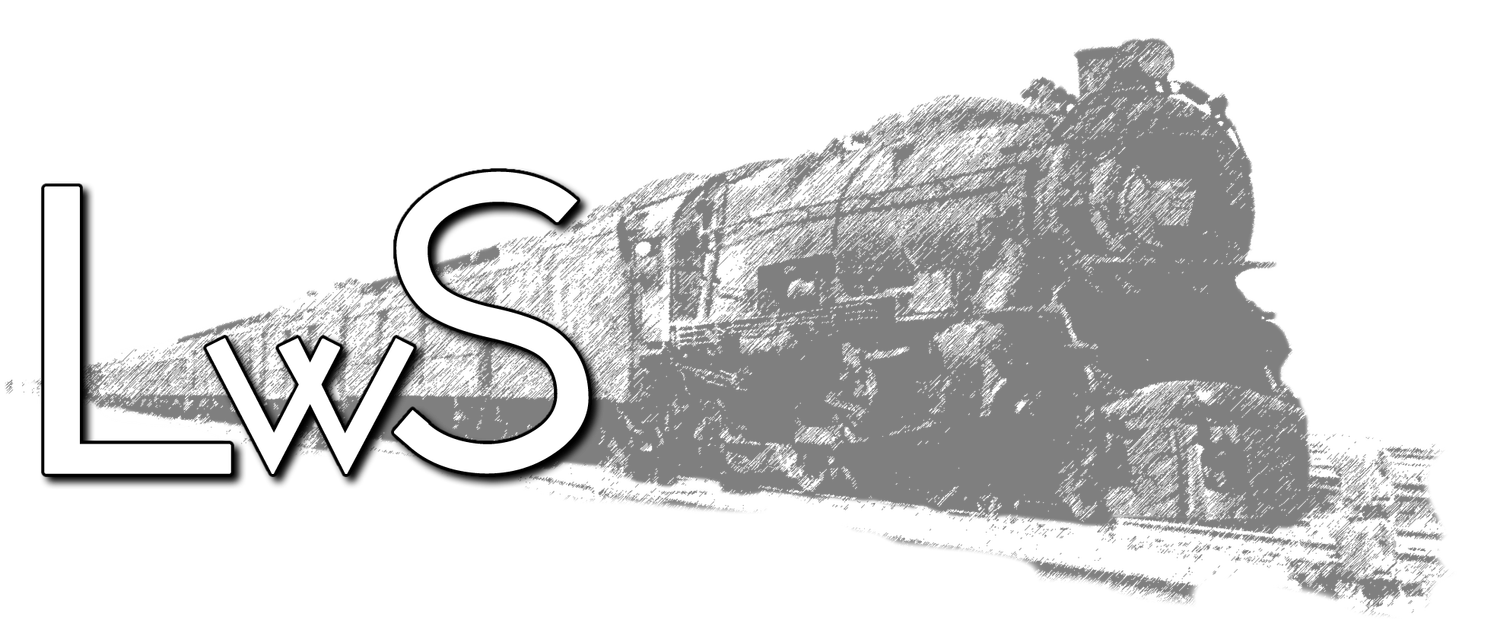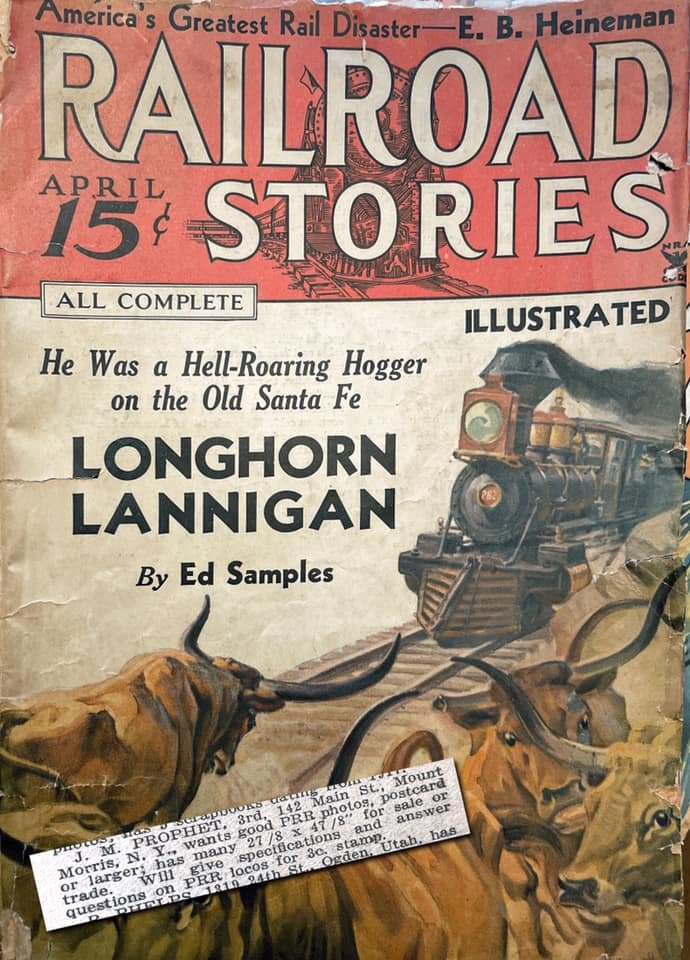John Prophet “In Print”
Prior to working with Russ Shapley to form the Buffalo Chapter of the Railroad Enthusiasts in 1938, John had another outlet for his vast interest and knowledge in the Pennsylvania Railroad. As I mentioned in a post a month or so back, John was a frequent ”contributor” to Railroad Stories Magazine; a pulp-style periodical that started in the 1920s. He was a subscriber of the magazine right around the time he was getting quite the railroad education by spending time at his family canning business in Mt. Morris, NY and observing shipments in and out of the facility made by the Pennsylvania Railroad.
A previous issue of the magazine asked its readers what they thought were the handsomest passenger engines out there. In the August 1935 issue, John’s response to the question was printed. While the other responses are short and directly to the point. John has one of the largest areas of the page set aside for his thoughts and reasoning on the subject. He left nothing out.
“PRR Photographs Wanted”
I’ve mentioned several times that John Prophet may have received news about upcoming camera formats or recording devices from any one of the dozens of photography or “electronics” magazines of the day. However, it never occurred to me that he’d go directly to a railroad-themed magazine in order to obtain photographs to add to his collection.
I’m a collector of pulp magazines from the 1920s-1950s. “Railroad Stories”, or “Railroad Magazine” as it came to be known in the 40s, is one of my favorites. The stories were mostly written by railroad men, and the articles are a step back in time to discover what the railroad industry was like during its heyday. One of the featured articles in each issue was something called “International Railroad Picture Club.” In the April 1935 issue, the article gives the reader some good insight into the best ways to photograph a locomotive. While the article is certainly interesting, the main reason why this section of the magazine exists in the first place is because at the end of each article is a multi-page list with dozens and dozens of name of folks who are willing to buy, sell, or trade photographs of trains with other members of the “IRPC.”
Low and behold, an ad was placed by John stating that he was looking for “good PRR photos, postcard or larger.” He was also offering 27/8 x 47/8’ pictures for sale or trade. If those numbers are in centimeters, they translate to roughly an 18 x 10 print! The last part of his ad is perhaps the most interesting; John will answer any questions about PRR locomotives as long as you include a 3-cent stamp for return postage.
I wonder where his pictures are that were that size. I also wonder if anyone answered his ad.
John never ceases to amaze me.
The “Manhattan Limited”
As I work on Season 2 of Living With Steam, I’m constantly reviewing John Prophet’s recording notes and photographs to come up with interesting stories to share in each episode. The photograph to the right is one that John handed to me when he and I started working on Living With Steam (in its first rendition) back in 1996. I remember him saying that if I wanted to see what it was like to have trains pulled by steam engines going through the center of town and how people reacted to the train, this photo helped show that ideology. I agree. Some folks are looking at the train while others just go about their business as if it’s not even there.
For us in 2021, it’s hard to imagine how much a part of daily lives the railroads were back in the 19th and early 20th centuries. Steam engines were the norm. The smoke, coal dust, and sounds were ingrained in our communities... especially in a city like Pittsburgh, PA.
The date is September 11, 1950 and John captured this incredible photo of a Pennsylvania K-4s and a T-1 pulling train 22, The Manhattan Limited, on its final approach to the Pennsylvania Station on Liberty Avenue after crossing the Allegheny River. This was a Chicago to New York train. The station itself is not in the picture as it would have been to the right and just out of range of John’s camera. Both engines are on the overpass bridge that carried the PRR tracks over 11th Street. Liberty Avenue is the street in front. The train is passing Tower “US”. The historical Byrnes & Kiefer Co. building is in the back and to the right. B & K were and still are manufacturers of baking supplies and baked goods.
If you compare John’s photograph with a Google Earth view of the same area today, you can see how the progression of time has really changed the area.
The “Pacemaker”
Going back to one of the recordings I featured in season 1 of Living With Steam, one of John Prophet’s favorite places to visit, but oddly only made a handful of recordings there, was New York Central’s Tower F in the Black Rock section of Buffalo. One of the trains that John recorded on what seemed like a regular basis was New York Central’s “Pacemaker” freight train.
“The New York Central System introduced it's "Pacemaker" freight trains in 1946. The service was skillfully marketed and aimed at recapturing L.C.L. (Less than Carl Load) traffic. The "Pacemaker" trains featured distinctive specially designed boxcars painted in a flashy vermillion and gray livery with "Pacemaker" written on the sides in script. The cars were equipped with high speed trucks that used stabilizers and bolsters to reduce incidents of in-transit damage. As "Pacemaker" service expanded the box car fleet grew to 1,000 cars.”
“The "Pacemaker" fast freights originally operated on an 11 hour schedule from Manhattan to Buffalo / Niagra Falls. Carrying the symbol NB-1 the "Pacemaker" left Manhattan at 7:45 PM and arrived at Buffalo 6:50 AM the following morning. By 1950 "Pacemaker Service" reached most Mid-Western cities within the Central's service region.”
By 1957 the Pacemaker service was dropped altogether in favor of the NYC “Early Bird” service which had been introduced in 1954.
In the photo below, John Prophet caught H7a engine 2007 pulling a Pacemaker train at an unknown locaetion. I can’t imagine seeing this beautiful engine pulling a long line of red and grey boxcars at top speed. down the Niagara Branch of the New York Central. This gave new meaning to the term “fast freight”… even though this particular train is sitting idle while the engine crew leans out the fireman’s side window. Perhaps waiting for orders? Or perhaps there’s an issue with 2007’s tender as water is seen pouring out of the left side. Either way, the train posed for John’s camera.



